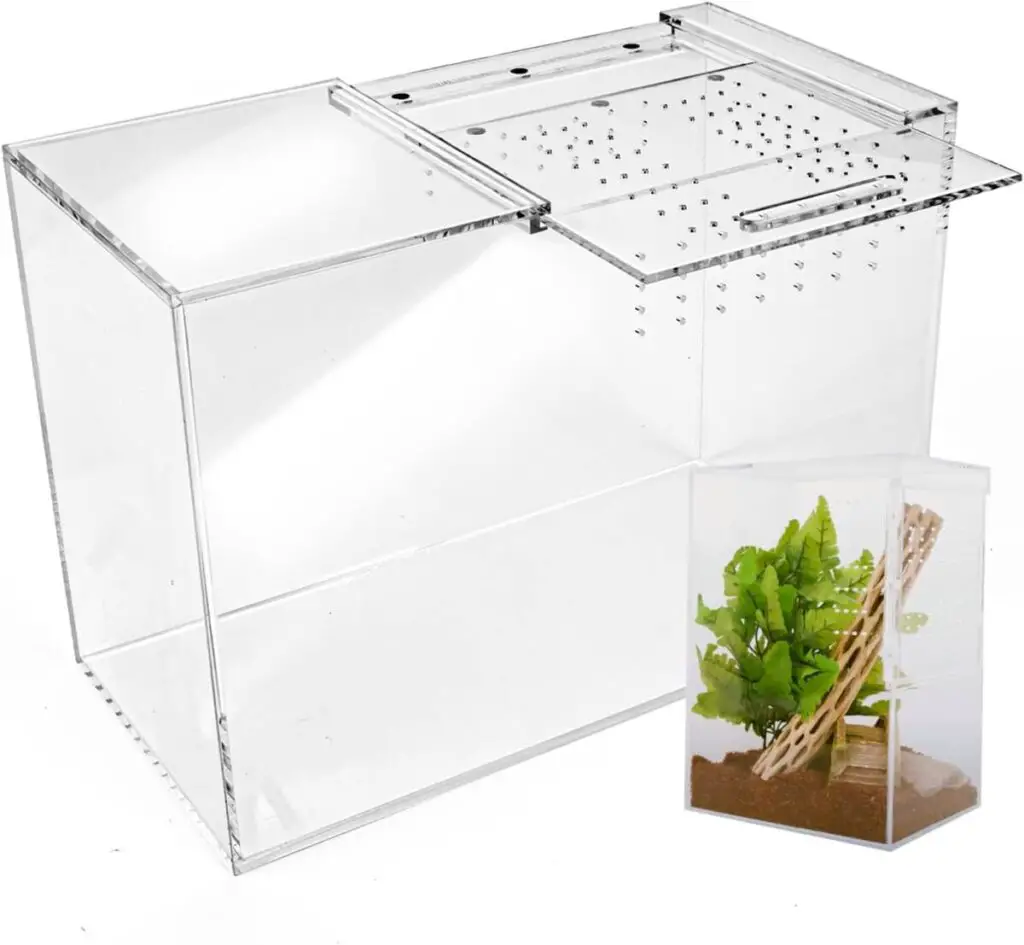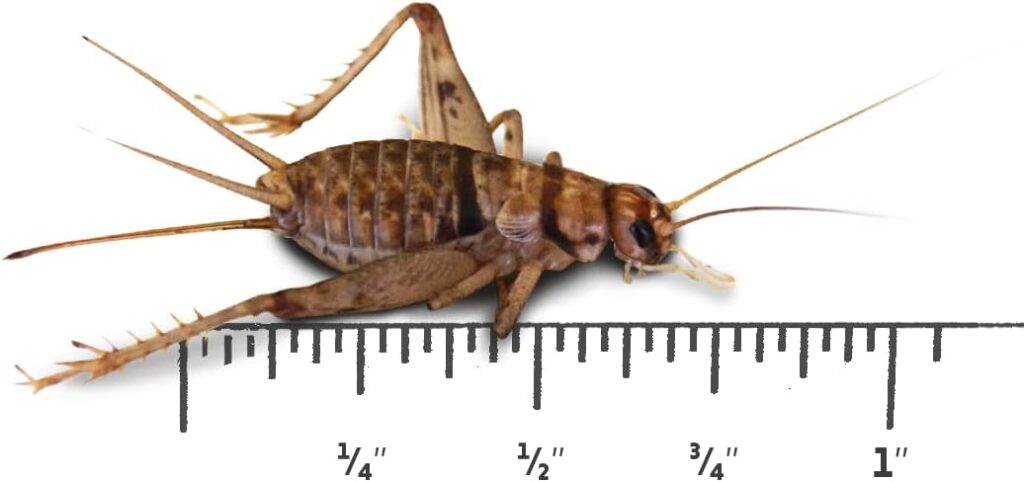If you plan to keep an exotic animal as a pet, tarantulas are a great choice. Here’s an end-to-end guide on how to keep tarantulas for beginners.
To keep a tarantula, prepare a container with vents and a secure lid. Lay some coir and put a water dish inside the housing. Then, house the tarantula inside. Feed the tarantula with crickets on a weekly basis. Replenish the water dish when it dries up.
A tarantula can be a cool exotic pet to keep. It’s also quite easy and hassle-free to keep a tarantula if you know how. Certainly, there are also safety aspects that you will also need to consider. Continue reading to learn more.
Things to Consider when Choosing A Tarantula
One of the key questions that anyone who wants to start keeping a tarantula is, which tarantula should I choose?
The best beginner-friendly tarantulas that you should start with are female Aphonopelma spp., Brachypelma spp. and Grammostola spp. They are docile, slow, hardy, easy to take care of, and can live for years. All these 3 genera are New World terrestrial tarantulas.
Here’s the list of best beginner-friendly tarantulas that you can keep.
New World vs Old World Tarantulas
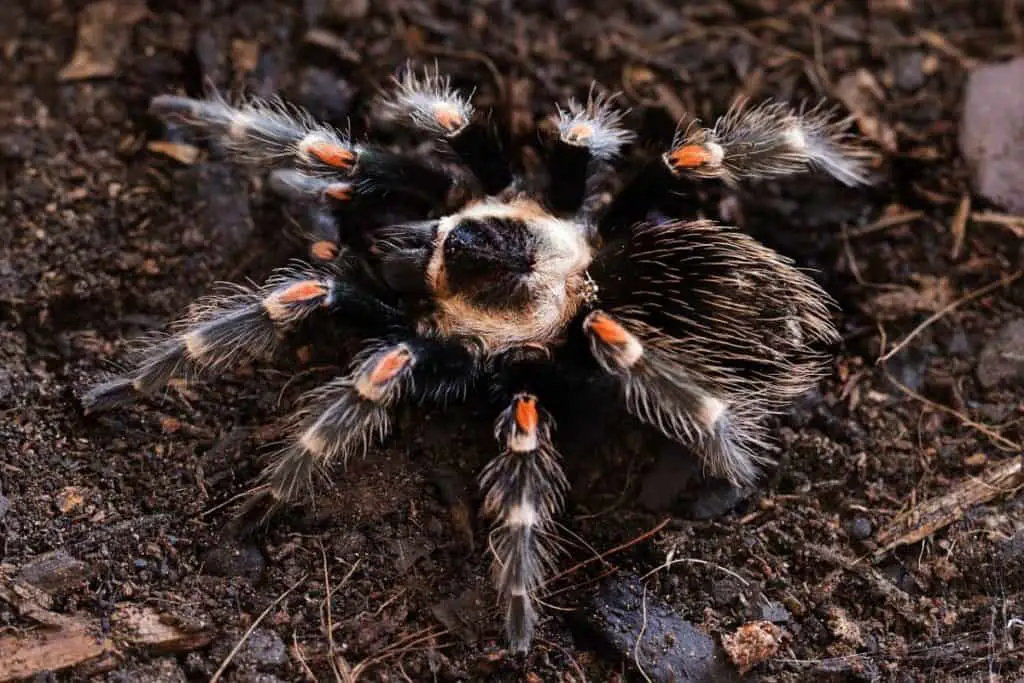
When it comes to exotic pets, in many cases people are interested in keeping species originated from the tropical region because of their uniqueness and the cool factor. The same applies to tarantulas. However, you need to know that those Old World (Eurasia and Africa) tarantula species are harder to keep than their New World (Americas) counterparts, especially since you are a beginner.
Old World tarantulas are typically faster and more aggressive. While they might look prettier, they can attack you more readily and they are capable of inflicting more painful and more venomous (although non-lethal) bites than the New World tarantulas. As a beginner, your obvious choice should be New World tarantulas.
Terrestrial vs Arboreal Tarantulas
On top of origin, there are 2 major groups of tarantulas: the terrestrial or ground-dwelling tarantulas, and the arboreal tarantulas that live on trees.
As a beginner, you should consider terrestrial tarantulas because they are less agile and sturdier than those arboreal tarantulas, which make the arboreal tarantulas difficult to handle. You should consider arboreal species only if you have experience keeping tarantulas.
Life Stages of Tarantulas
Technically, there are 3 stages in the life cycle of a tarantula: egg, juvenile and adult.
Eggs hatch into 1st instar juveniles that stay in the egg and feed on the yolk. Then they molt into the second instar and disperse. They continue to molt into 3rd instars, 4th instars etc.
After several molts, they turn into sexually mature adults, which are called the ultimate instar. The stage before ultimate instar is called the penultimate instar, and the stage before that is the antepenultimate instar. Female adult tarantulas can continue to molt to post ultimate instars while the male adult tarantulas can’t.
Different hobbyists may have their own definition on different stages. Some may call the first few instars “spiderling” or “sling”; older juvenile instars that start to resemble adult tarantula might be called the sub-adult, while anything in between might be called “juvenile”. Some would call the tarantulas based on sizes. For instance, they may call anything bigger than 3″ as sub-adult. So, don’t be bothered too much about the jargon.
As a beginner, I highly recommend you to start with either antepenultimate instar or penultimate instar. Those 2 stages would probably correspond to the term sub-adult. Adult tarantula is also a good option, but you will miss the chance to experience molting if you are keeping a male tarantula.
Young juveniles (or spiderling) are not suitable for beginners because they are too small and fragile. Moreover, many of them would not be able to survive until adulthood. You can consider starting with young juveniles after you gain more experience handling tarantulas.
Sex of Tarantula
Female adult tarantulas can live for up to 20 years or more while the male adult tarantulas can only live for a year or so. Because of that, they are generally more expensive than their male counterparts.
Because of her longevity, most people will want to keep a female tarantula. If you are worried that tarantulas might not suit you and you do not want to make a 20-year commitment, choosing a male tarantula might make sense.
If you are keen to breed your own tarantulas, get both male and female.
Where to Get Your First Tarantula
If you need help looking for places to buy tarantulas, Google and social media platforms will be your best friend. Arachnoboards is also a good place to search for sellers.
Look for reputable breeders, preferably those who are located near to you. You don’t want your tarantula to stay too long in the mail parcel.
I urge you to get captive bred tarantulas instead of wild tarantulas. For one, excessive capturing of tarantulas from the wild can threaten its existence. Secondly, it can be hard to determine the age of the wild tarantula, if it is an adult.
A word of advice: please prepare the housing before getting your pet tarantula!
Tarantula Care
Tarantula Housing
Tarantula can be housed in any sort of container as long as it is escape-proof. Preferably, the container should have an opening big enough for you to put in the feeder organisms but small enough so that the tarantula doesn’t escape while you are trying to feed it..
In case you are not aware of, tarantulas need to be housed individually. Otherwise, they will cannibalize each other.
The tarantula should be placed away from your curious kids or pets so that they won’t accidentally release it.
Try not to use acrylic container that need to be assembled. Those containers are usually not secure enough and you might accidentally release the tarantula.
Size of Housing
You may wonder how much room do tarantulas need? Well, surprisingly little. A tarantula occupies a very small space. In fact, you shouldn’t house it in an overly large terrarium because the tarantula is an ambush predator. It doesn’t actively hunt for prey. If the terrarium is too big, it might take forever for the prey to walk past where the tarantula is hiding.
Before I proceed to the size of housing, you will need to understand the term “leg span”. Leg span of a tarantula is the measurement of distance between the tip of the left front leg and the tip of the right hind leg (or right front to left hind legs). Leg span is usually used to describe the size of the spider.
As a general rule of thumb, the width and length of the tarantula housing should be about 2-3 times the leg span of your tarantula. Meanwhile, the height of the housing can vary depending on the species of tarantula that you are keeping.
Terrestrial tarantulas are poor climbers, but they do climb. If the housing is too tall, they can injure themselves from falling. Hence, the distance between the floor and lid should be somewhere between one third the leg span to a leg span of your tarantula. This can be achieved by adding more substrates into the housing.
If you are keeping arboreal species, you can use a taller container, with a height about 2-3 times the container width.
Depending on the stages and age of your tarantula, you might want to consider using a temporary housing instead of a permanent one. For instance, if you are keeping spiderling of early instars, it is probably wise to save some money by using a deli container instead of buying a terrarium from pet stores.
Secured Lid
Tarantulas are strong creatures. They can lift up the housing lid if it is not heavy or secure enough. You may need to tie the lid with a strap or put something heavy on the lid to prevent the tarantula from escaping.
Do not use a lid with a light mesh screen. The tarantula can easily chew through a light aluminum mesh and escape! There is also a risk of injuring your tarantula because its claw may get stuck on the wire mesh.
If your tank comes with a mesh lid, you will need to remove the mesh, and replace it with acrylic sheets. Drill some holes for ventilation before gluing the acrylic sheet with silicon.
Leave the silicon to cure for 2-3 days before using the lid. You want to avoid any harmful volatiles emitted from the silicon glue to harm your tarantula.
Ventilation
The housing that you choose must have sufficient vents to allow proper ventilation. Fortunately, most commercially available housing have vents built on its cover or the housing itself.
If you are using deli containers, poke a dozen holes on the container wall or lid. Poor ventilation can lead to the growth of mold, which can harm your tarantula or create a mess for you to clean up.
Substrates for Tarantula
Substrates are important for tarantulas, especially those who burrow. You will need substrates that can be compacted so that the burrow doesn’t collapse easily. The most commonly used substrates for tarantula are coir or coco fiber and pesticide-free potting mix.
For terrestrial tarantulas, fill the housing with coir or pesticide-free potting mix and compress them. Keep the space between substrates and lid at least ⅓ but not more than the leg span of your tarantula. Arboreal species don’t need substrates.
In general, the more substrates you put, the better it is. This will give the tarantula enough space to burrow, at the same time retaining enough water to regulate the humidity within the housing.
Decorating the Tarantula Housing
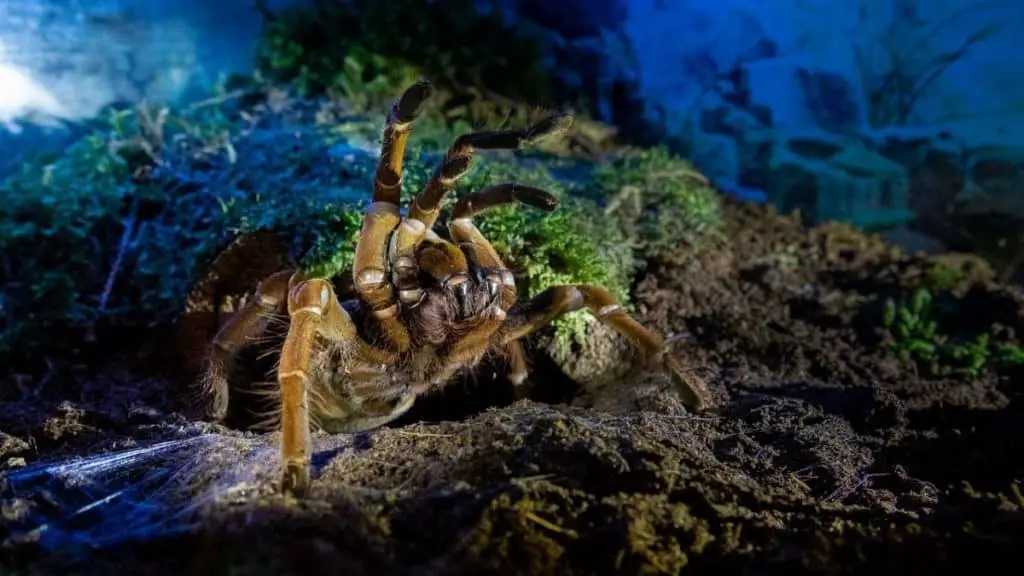
Technically, your tarantula doesn’t appreciate any decoration in the enclosure. But as the owners, most of us would appreciate decorating the enclosure for a better tarantula-keeping experience.
You can decorate the housing with cork barks or rift woods. For terrestrial tarantula, you can consider introducing a cut coconut shell or hollow log, half buried in the substrates. The tarantula may use that as a foundation to build its burrow. Some may reject it though.
For arboreal species, you need to erect or lean the cork bark along the wall of the housing so that your tarantula can climb and build its silk nest. The erected cork bark can be secured on the container wall with hot glue or silicon.
Avoid decorating the housing with live plants because plants require sunlight and nutrients, which can be difficult to manage. However, if you are confident, incorporating live plants into your tarantula enclosure is certainly something you can try.
Lighting, Temperature and Humidity for Tarantula
Lighting
Tarantulas do not require any sort of lighting. In fact, they prefer to stay in the dark. You should keep them under shades and away from direct light.
If you want to use display lighting, try to use red LED light. Tarantulas are not sensitive to red light and hence, using red light will not cause much disturbance to them. However, red light is likely more expensive than white light.
You shouldn’t leave the lighting on for too long, especially if you are using white light. Turn off the lighting once you are done observing your tarantula.
Temperature
Tarantulas typically don’t require temperature control. All species can be kept at the temperature you are comfortable with.
Do bear in mind that the rate of metabolism will be faster if your tarantula is kept at a higher temperature. This means your tarantula will grow (age) and get hungry faster when kept at a higher temperature.
Temperature control might be required if you keep tarantula originated from other regions with different climates from where you stay. For example, if you are keeping tropical tarantula species in temperate regions (which you shouldn’t, as a beginner), you will need to provide them extra warmth in the winter.
If you have kept reptiles before, you might naturally think of heat mats. The issue with a heat mat is temperature control. You can’t control the desired temperature accurately and there is a risk of frying your tarantula.
Hence, some people prefer to put the tarantula in a cabinet and heat up the air in the cabinet instead of heating the tarantula housing directly.
Put the heat mat beside the tarantula housing and close the cabinet so that the heat generated by the heat mat doesn’t escape. You can also use a warm/white light bulb instead of a heat mat. Just make sure the light doesn’t shine directly onto your tarantula because it prefers a darker environment. Use cardboard to block the light if you need to.
If you want to use a heat mat to directly warm up your exotic tarantula in the winter, put the heat mat under the corner but not the center of the tarantula housing. Monitor the temperature closely so that you don’t kill your tarantula by overheating it.
If you are providing extra heat to your tarantula, pay attention to the humidity in the housing. The extra heat will make the water in the substrates evaporate faster. You might need to replenish the water more frequently.
Water and Humidity
Maintaining the right level of humidity and giving your pet tarantula enough water is crucial for the health being and survival of your tarantula.
Your tarantula should get enough water from its food. However, it is good to provide a water dish as a backup to the tarantula. You can put some pebbles in the water dish to prevent any feeder insects from drowning.
You can provide humidity by watering the substrates on a biweekly basis. The substrates will hold the water and slowly release water vapor through evaporation to provide humidity. Note the tarantula prefers a dry contact surface. When watering, do not directly water on your tarantula or its burrow. Instead, water from 1 corner of the housing and let the opposite corner dry.
Tarantulas from tropical regions require more humidity than their arid counterparts.
How to Feed Tarantulas
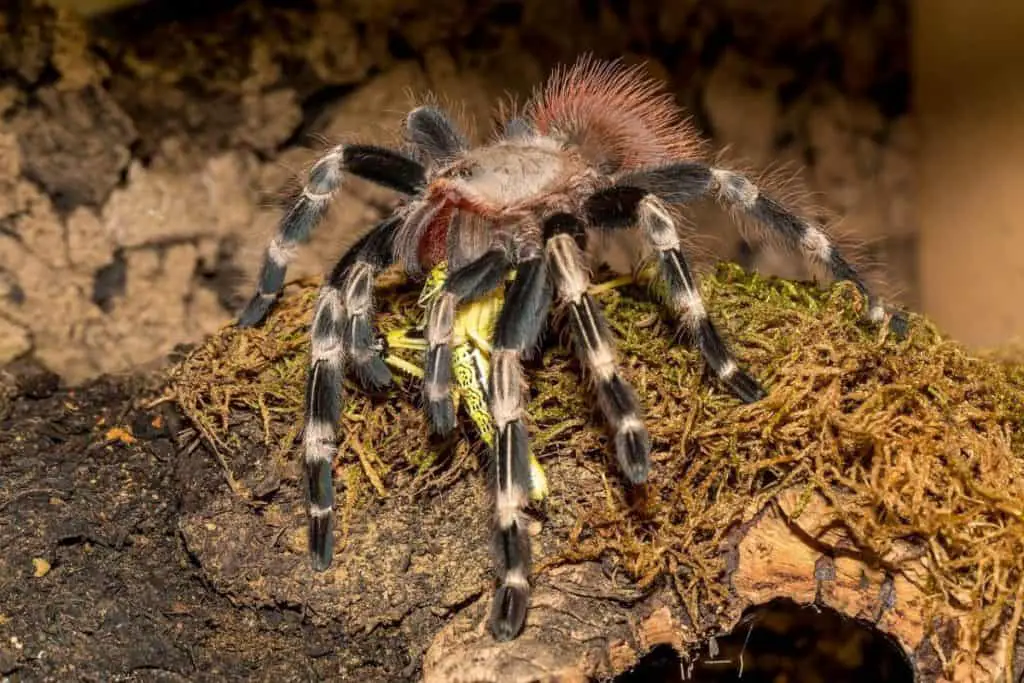
Feed your juvenile tarantula with 2-6 crickets once a week until it grows bigger than 2”. Gradually reduce the amount of crickets to 2 crickets a week as the tarantula grows into adult. If your tarantula grows beyond 8”, double the food. Feed your tarantula at night since they are nocturnal.
You might be puzzled on the amount of food required by adult versus juvenile tarantulas. Everyone would assume an adult tarantula requires more food due to their size. The fact is, juvenile tarantulas need more food to sustain their growth rate. As they grow older, their metabolic rate decreases and hence you can reduce the amount of food offered.
In general, tarantulas have better appetite at warmer temperatures than at lower temperatures. Pregnant tarantulas will also take more food.
If your tarantula doesn’t feed on the prey offered in 3-4 days, you should remove the prey from the tarantula housing. Otherwise the prey may be starved to death, and most tarantulas won’t feed on dead bodies.
Some people may suggest removing the uneaten prey on the next day to prevent the prey from disturbing or even harming the tarantula. That’s unnecessary unless the prey is stronger and bigger than your tarantula (which is not advisable in the first place) or if your tarantula is sick or injured.
Either way, you don’t have to worry too much if your tarantula doesn’t eat. Just wait for a few days and try to feed it again.
You may encounter situations where your pet tarantula fasts for months without apparent reasons. If you find your tarantula ignoring the food for months, don’t panic and just let it be. Tarantulas are ambush predators. In nature, they may need to wait for days or weeks before they can get their prey. Hence, they are “built” to survive with minimum food. Make sure you provide enough water to the tarantula and it will be fine.
Tarantulas eat a wide range of small animals. You can feed your tarantula with roaches, mealworms, or superworms on top of crickets. Larger species can feed on mice.
If you want to use mealworms or superworms, you need to put them in a shallow dish so that they will not escape and burrow into the substrates. Add a little bit of oatmeal or bread crumbs into the dish so that they can survive long enough until the tarantula takes them.
On rare occasions, tarantulas may feed on fresh carcasses if they think it is alive. They might also feed on meat or fruit. But those are exceptions rather than a norm.
You should avoid feeding the tarantula with a prey larger than the tarantula’s abdomen (also known as the opisthosoma) especially if it is a juvenile.
Tarantula Molting Care
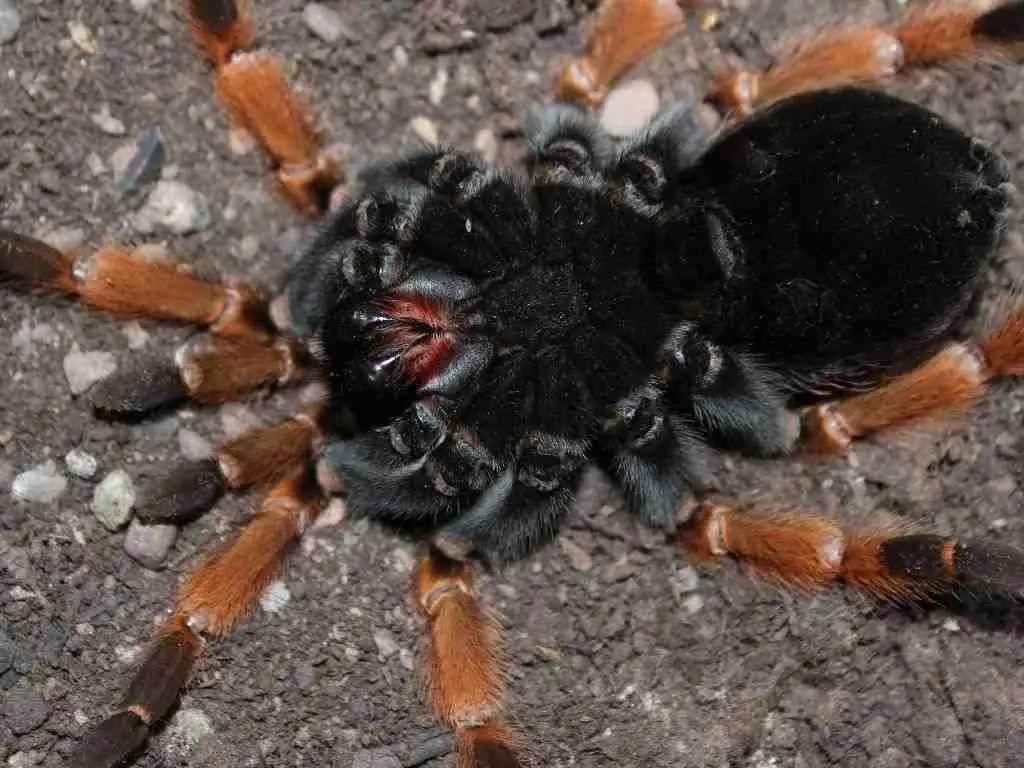
Tarantulas grow by molting. Younger juveniles molt at a higher frequency (eg. every month) than the older tarantulas (eg. every year or every 2 years). The number of molts varied in species, sexes, and even individual tarantula. Male tarantula stop molting after reaching adulthood while female tarantula continues to molt
If you are keeping a New World tarantula, you should be able to observe a light color “bald patch” on its hairy abdomen or opisthosoma. When the bald patch turns black, molting is imminent. This is not visible in Old World tarantulas – another reason you should start with New World tarantulas.
A few days or weeks prior to molting, the tarantulas will refuse to eat anything. Make sure you don’t leave any prey in the container when you see signs of molting. This is because the tarantula is extremely vulnerable during molting. Fill up the water dish to keep your tarantula hydrated.
When molting, terrestrial tarantulas will roll over and lie with its back on the substrates as if it is dying (but it is not). That’s why the height between top substrate and housing lid should be at least ⅓ the leg span of the tarantula. Otherwise it will have difficulty rolling over.
Sometimes, tarantulas may build a silk molting cradle on the ground and molt on it. They might lay their sharp urticating hairs (refer to Handling Tarantula section) around the molting cradle to defend themselves when they are molting.
The molting process can take a few hours or days. Younger tarantulas molt faster than the older tarantulas. Remember, do not touch or handle your pet tarantula at this stage because it is extremely vulnerable!
After the tarantula finishes molting, it takes up to a week or two (faster for younger tarantulas and slower for older tarantula) for its fangs and skin to become fully hardened. This means your tarantula is still vulnerable. Hence, do not immediately give the tarantula food and do not touch or handle it.
If your tarantula has lost its limb, it can regenerate its limb during the molt. The regenerated limb will be smaller, but grow bigger after each molt.
Handling Tarantulas

I bet you must have seen photos of people holding tarantulas on their hands, or letting the tarantula crawl on their face. It looks cool but you should really avoid that.
Avoid handling tarantulas unless it is really necessary to prevent injuring the tarantula and yourself. Tarantulas don’t like to be handled, and there’s no way to tame them.
Tarantulas will not attack you unless they feel threatened. Even if they feel threatened, most of the time they will run instead of biting you. If the tarantula bites you when you are holding it, you might instinctively throw it off or crush it. Not only you hurt yourself, you also hurt (and might kill) the tarantula.
On top of bites, you need to pay attention to the hairy New World tarantulas. To make up for their more docile nature, the New World tarantulas have urticating hairs on their abdomen.
Urticating hairs are sharp “hairs”. When they feel threatened, they point their abdomen towards the threat and rapidly kick their urticating hairs off to produce a volley of hairs shooting towards the threat. The hairs can cause some skin irritation, and can be devastating if they hit your eyes. If you are worried, you can reduce the risk by wearing nitrile gloves and goggles if you absolutely have to handle the tarantula.
Always use a pair of tweezers when you want to put something into and remove something from the tarantula housing. That includes your feeder insects and water dish.
As a beginner, the only event where you need to handle the tarantula directly is when you need to re-house it. To do that, prepare a disposable cup with a lid and a small paint brush. Make a hole at the bottom of the disposable cup so that it is big enough to stick the brush in.
Once you are ready, coax the tarantula into the cup with the paint brush and cover the cup with a lid. Make sure you secure the lid or the tarantula can easily escape! To transfer the tarantula into the housing, push the tarantula using the paint brush through the hole on the cup that you have made earlier.
Cleaning the Tarantula Housing
Unlike many other pets, tarantula housing requires very little cleaning. As and when you see unconsumed body parts such as cricket legs, you should remove it using a tweezer. Otherwise, you will have a mold issue.
After feeding, tarantula will discard the undigested food mainly consisting of the feeder insect’s exoskeleton in the form of bolus or “spit-ball”. If you see those boluses outside the burrow, remove them using a tweezer. Otherwise it can attract and breed fungus gnats when it is wet.
A thorough cleaning of the tarantula housing should be done once a year to reduce the disturbance to the tarantula. To do that, remove the tarantula from the housing (refer to How to Handling Tarantula section). With your gloves on, carefully take out all the decors and rinse them under running water to remove any urticating hairs. Dispose the substrates and wash the housing with mild dishwashing soap. Then, put in new substrates and re-introduce your tarantula into the housing.
Recommended Supplies
Below are the supplies that I recommend you to get for your tarantula. Note that I get a small commission when you buy the items through the links in this page. This helps me to maintain the site without incurring additional costs to you.
Final Words
By now, you should realize that keeping a tarantula as a pet is way easier than you would have thought. I hope the information shared here is useful for those who want to start keeping tarantula. If you want to learn more about keeping tarantulas, do check out my recommended books on tarantula keeping.
Additional Information:
Onboarding your new tarantula
What’s the first thing that you need to do once you get your new tarantula? Simple! Put it into the housing and keep it in the dark for 3-4 days. Make sure the substrate is adequately moist and the water dish is filled with water. The tarantula needs some time to get used to the new environment. After that, you can start feeding the tarantula.
What to do if you get bitten by a tarantula?
While all tarantula bites are venomous, they are not known to be lethal. The first thing that you should do when you get bitten is to control yourself so that you don’t spontaneously smash the tarantula!
Then, wash your wound and cover it with band aid. Don’t apply any grandma remedies on the wound. You might experience swelling or itches on the wound, which should subside in a day or two. If you experience more serious symptoms such as nausea and irregular heartbeat, please consult a doctor.
The urticating hairs hit my eyes!
If the urticating hairs of the New World tarantula hit your eyes, you will have to go to a clinic or hospital immediately! Don’t rub or touch your eyes as this will only make it worse.


